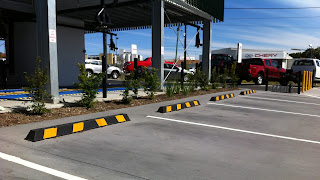A wheel stop is the best way to prevent damage to your warehouse floors or loading dock. Best Wheel stops can prevent scuffing, gouging, and other wear and tear on your floor.
They also keep trucks from driving over any obstacles that may be left behind by other vehicles.

What is Wheel Stop?
Wheel stops are barriers that is placed at the entrance of a facility to prevent vehicles from entering the premises. They can be used to protect people, property, and equipment. They should be placed at a distance from the entrance of a facility so that it does not interfere with normal traffic flow into or out of your parking lot or driveway.
Pros of Wheel Stop
- Protect your walls and floors.
- Reduce the risk of injury.
- Reduce the risk of damage to your equipment and floor or wall.
Types of Wheel Stop
The types can be classified into three main categories. Some are made from recycled materials, such as plastic bottles or other waste products. They’re often used in conjunction with other types to help prevent damage to the ground beneath them. Rubber – Rubber is a popular choice because it’s durable and easy to install; however, these can’t be used on grass because they’ll sink into the soil instead of staying upright as other materials do.
- Recycled Plastic
Recycled plastic is an excellent choice and It’s made from recycled plastic bottles, which means it’s durable and long-lasting. Recycled plastic comes in a variety of colours, so you can choose the one that best suits your needs and aesthetic preferences. And installation is easy–simply place them on the ground where you want them!
- Rubber
Rubber is a good material that can be used for safety. It’s soft and can be easily damaged by heavy equipment, but it’s easy to recycle and not very expensive. Rubber is also relatively durable, but it doesn’t last forever like steel or concrete will.
- Poly (LLDPE)
Low-Density Polyethylene (LDPE) is a thermoplastic material that can be moulded into all kinds of shapes. It’s flexible and durable, making it ideal for wheel stop in every aspect. The most common form of LDPE is high-density polyethylene (HDPE), which has better tensile strength than LDPE but lower impact resistance.
This makes it less suitable for applications where there will be heavy traffic or impact from vehicles driving over the wheel stop repeatedly, such as on construction sites or in parking lots where trucks often park overnight.
Final Words
We hope that this article has helped you understand the different types of wheel stops, their benefits and drawbacks. If you’re still unsure about which type is best for your needs, we recommend starting with a simple rubber wheel stop.
These are easy to install and don’t require any maintenance but they do have some limitations when it comes down to heavy-duty applications such as parking lots or warehouses where large trucks may drive over them repeatedly throughout the day.
Source:https://expandablebarriers.blogspot.com/2023/05/a-comprehensive-guide-on-wheel-stops.html